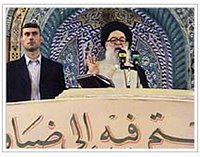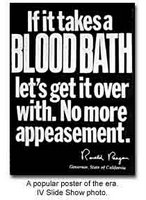"The CIA officers that Yousef worked with closely impressed upon him one rule: never use the terms sabotage or assassination when speaking with visiting congressmen."
-- Steve Coll, Ghost Wars
 Gunboat diplomacy had been defeated by car bombs in Lebanon, but the Reagan administration and, above all, CIA Director William Casey were left thirsting for revenge against Hezbollah. "Finally in 1985," according to the Washington Post's Bob Woodward in Veil, his book on Casey's career, "he worked out with the Saudis a plan to use a car bomb to kill [Hezbollah leader] Sheikh Fadlallah who they determined was one of the people behind, not only the Marine barracks, but was involved in the taking of American hostages in Beirut… It was Casey on his own, saying, ‘I‘m going to solve the big problem by essentially getting tougher or as tough as the terrorists in using their weapon -- the car bomb.'"
Gunboat diplomacy had been defeated by car bombs in Lebanon, but the Reagan administration and, above all, CIA Director William Casey were left thirsting for revenge against Hezbollah. "Finally in 1985," according to the Washington Post's Bob Woodward in Veil, his book on Casey's career, "he worked out with the Saudis a plan to use a car bomb to kill [Hezbollah leader] Sheikh Fadlallah who they determined was one of the people behind, not only the Marine barracks, but was involved in the taking of American hostages in Beirut… It was Casey on his own, saying, ‘I‘m going to solve the big problem by essentially getting tougher or as tough as the terrorists in using their weapon -- the car bomb.'"
 nese agents led by a former British SAS officer and financed by Saudi Ambassador Prince Bandar. In March 1984, a large car bomb was detonated about 50 yards from Sheikh Fadlallah's house in Bir El-Abed, a crowded Shiite neighborhood in southern Beirut. The sheikh wasn't harmed, but 80 innocent neighbors and passersby were killed and 200 wounded. Fadlallah immediately had a huge "MADE IN USA" banner hung across the shattered street, while Hezbollah returned tit for tat in September when a suicide truck driver managed to break through the supposedly impregnable perimeter defenses of the new U.S. embassy in eastern (Christian) Beirut, killing 23 employees and visitors.
nese agents led by a former British SAS officer and financed by Saudi Ambassador Prince Bandar. In March 1984, a large car bomb was detonated about 50 yards from Sheikh Fadlallah's house in Bir El-Abed, a crowded Shiite neighborhood in southern Beirut. The sheikh wasn't harmed, but 80 innocent neighbors and passersby were killed and 200 wounded. Fadlallah immediately had a huge "MADE IN USA" banner hung across the shattered street, while Hezbollah returned tit for tat in September when a suicide truck driver managed to break through the supposedly impregnable perimeter defenses of the new U.S. embassy in eastern (Christian) Beirut, killing 23 employees and visitors. Despite the Fadlallah fiasco, Casey remained an enthusiast for using urban te rrorism to advance American goals, especially against the Soviets and their allies in Afghanistan. A year after the Bir El-Abed massacre, Casey won President Reagan's approval for NSDD-166, a secret directive that, according to Steve Coll in Ghost Wars, inaugurated a "new era of direct infusions of advanced U.S. military technology into Afghanistan, intensified training of Islamist guerrillas in explosives and sabotage techniques, and targeted attacks on Soviet military officers."
rrorism to advance American goals, especially against the Soviets and their allies in Afghanistan. A year after the Bir El-Abed massacre, Casey won President Reagan's approval for NSDD-166, a secret directive that, according to Steve Coll in Ghost Wars, inaugurated a "new era of direct infusions of advanced U.S. military technology into Afghanistan, intensified training of Islamist guerrillas in explosives and sabotage techniques, and targeted attacks on Soviet military officers."  U.S. Special Forces experts would now provide high-tech explosives and teach state-of-the-art sabotage techniques, including the fabrication of ANFO (ammonium nitrate-fuel oil) car bombs, to Pakistani intelligence service (or ISI) officers under the command of Brigadier Mohammed Yousaf. These officers, in turn, would tutor thousands of Afghan and foreign mujahedin, including the future cadre of al-Qaeda, in scores of training camps financed by the Saudis. "Under ISI direction," Coll writes, "the mujahedin received training and malleable explosives to mount car-bomb and even camel-bomb attacks in Soviet-occupied cities, usually designed to kill Soviet soldiers and commanders. Casey endorsed these despite the qualms of some CIA career officers."
U.S. Special Forces experts would now provide high-tech explosives and teach state-of-the-art sabotage techniques, including the fabrication of ANFO (ammonium nitrate-fuel oil) car bombs, to Pakistani intelligence service (or ISI) officers under the command of Brigadier Mohammed Yousaf. These officers, in turn, would tutor thousands of Afghan and foreign mujahedin, including the future cadre of al-Qaeda, in scores of training camps financed by the Saudis. "Under ISI direction," Coll writes, "the mujahedin received training and malleable explosives to mount car-bomb and even camel-bomb attacks in Soviet-occupied cities, usually designed to kill Soviet soldiers and commanders. Casey endorsed these despite the qualms of some CIA career officers."
~~~~~
This is an excerpt from the fascinating account, History of the Car Bomb, by Mike Davis as a preliminary sketch for a book-length study.
Found at History News Network (I always find interesting stuff there.)
[italics mine]



No comments:
Post a Comment